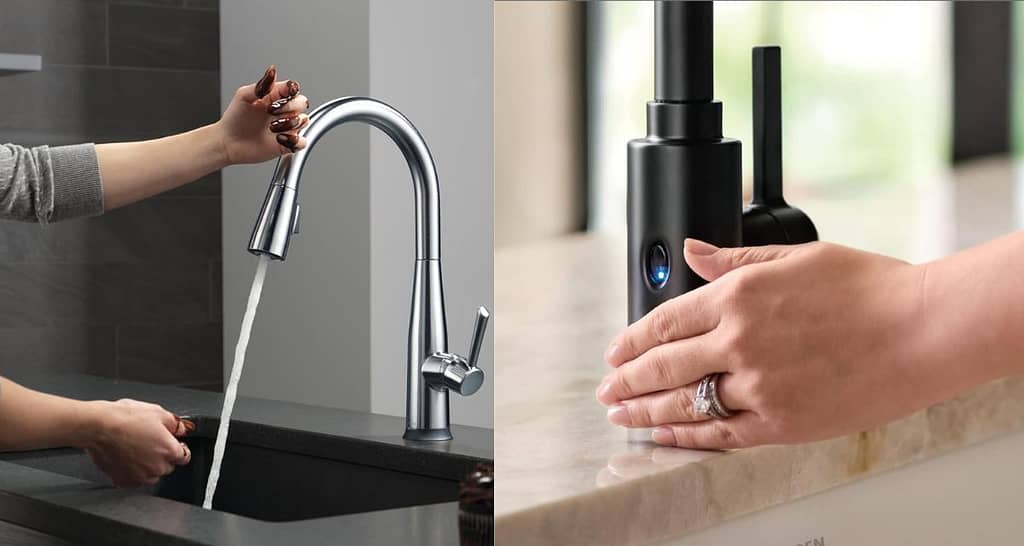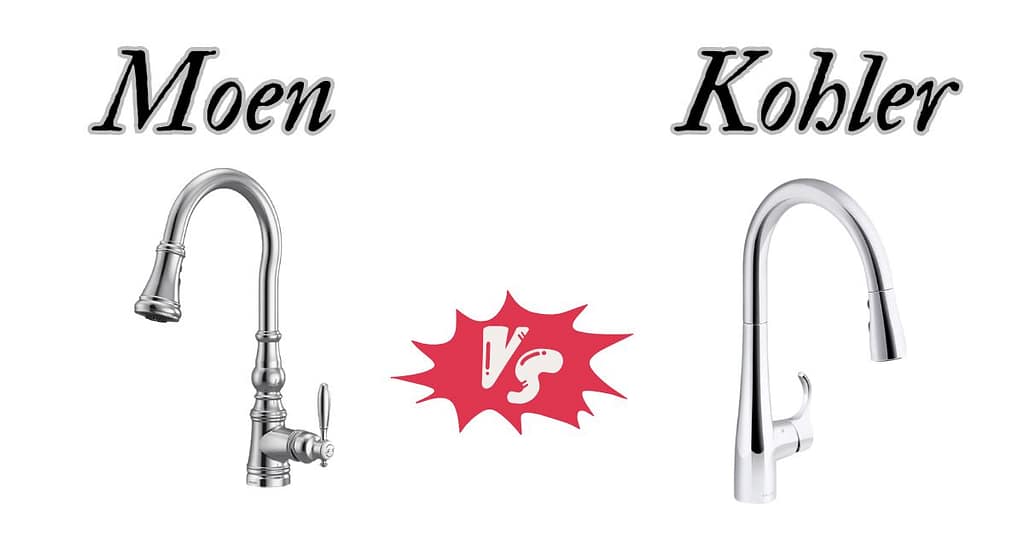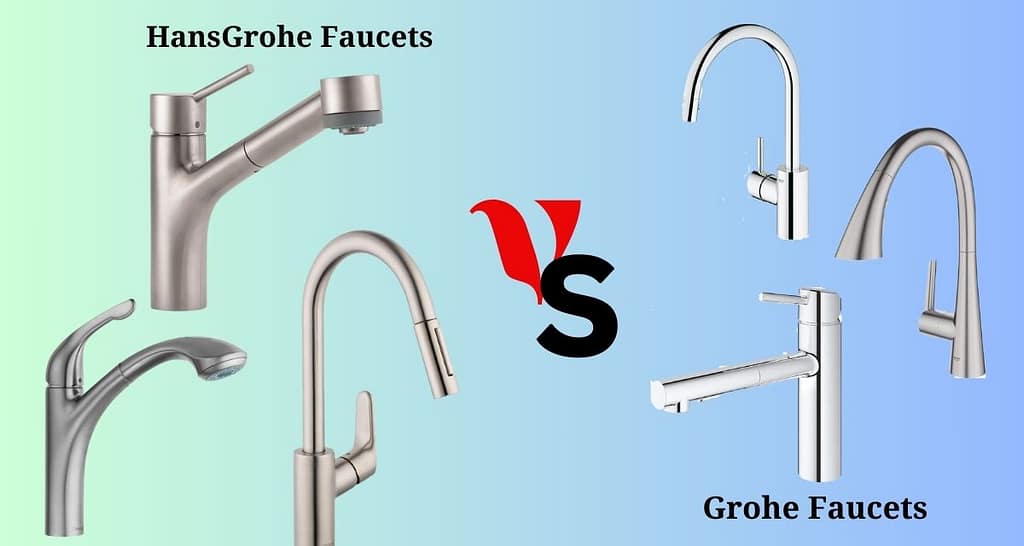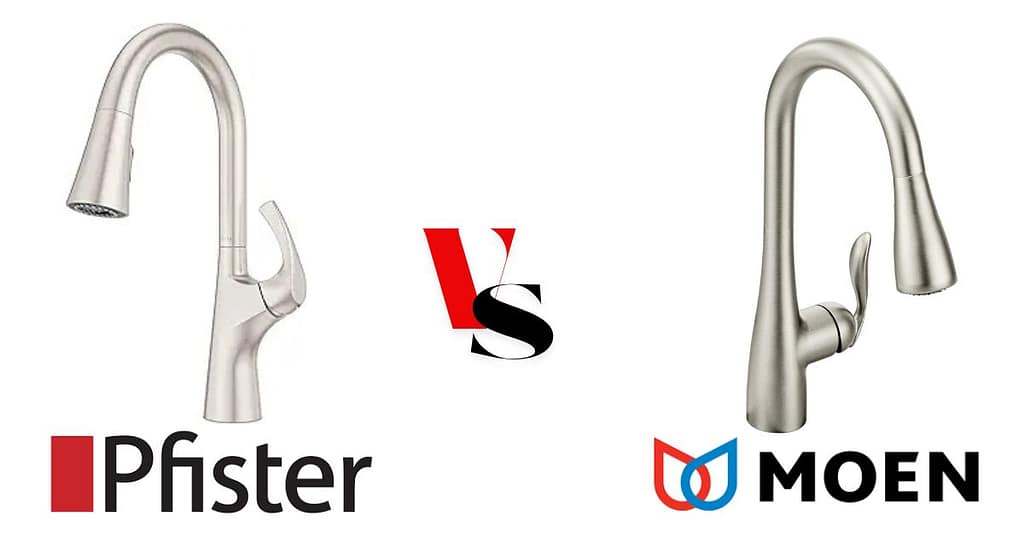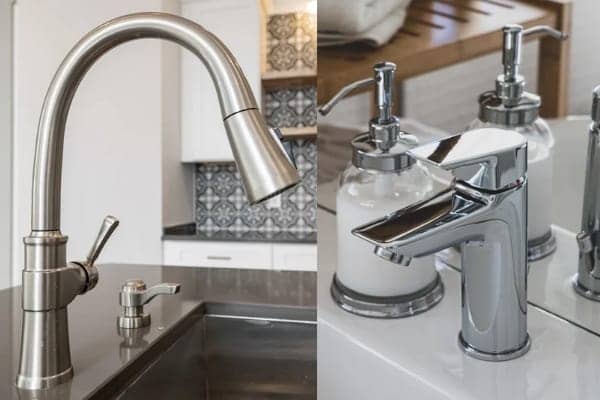
Faucets are an essential part of every household, providing us with the convenience of clean water for various tasks. However, not all faucets are created equal. Bathroom and kitchen faucets serve distinct purposes, and their design and functionality differ accordingly.
In this comprehensive guide, we will delve into the key differences between bathroom faucets and kitchen faucets to help you make informed choices when it comes to your home’s plumbing fixtures. Let’s start comparison Kitchen vs. Bathroom Faucets!
Purpose and Usage: Understanding the Distinct Roles
In the world of faucets, it’s not just about looks – functionality plays a key role. The key difference between bathroom faucets and kitchen faucets? Their intended purpose and usage.
Bathroom Faucets: Your Trusty Companions for Personal Care
Imagine your morning routine: splashing water on your face, brushing your teeth, or washing your hands after a quick pit stop. These everyday tasks are precisely what bathroom faucets are designed for. They’re all about convenience and comfort during your personal hygiene moments.
Kitchen Faucets: The Workhorses of Culinary Adventures
Now, switch gears to your bustling kitchen. You’re washing dishes, filling up a pasta pot, or giving those fresh vegetables a good rinse. Kitchen faucets step up to the plate here. They’re built to tackle the heavy lifting, with higher water flow rates and sturdier designs that can handle the rigors of the kitchen.
In a nutshell, while bathroom faucets excel at gentler, everyday tasks with lower water flow and pressure needs, kitchen faucets are the robust, go-to options for the more demanding chores in your culinary journey. So, when it comes to choosing between the two, consider the space and the tasks at hand, and you’ll find the perfect faucet match for your needs.
Size and Reach: Kitchen vs. Bathroom Faucets
When it comes to faucets, size matters – but it’s not a one-size-fits-all affair. The disparity between bathroom faucets and their kitchen counterparts lies in both their dimensions and reach.
Bathroom Faucets: Petite and Purposeful
Think about your bathroom sink or countertop – it’s a space-efficient oasis designed for personal care. Correspondingly, bathroom faucets are petite powerhouses, engineered to snugly fit within these compact confines. Their compact size complements the intimate nature of bathroom activities like handwashing and tooth brushing.
Kitchen Faucets: Grand Designs for Culinary Expeditions
Now, switch gears and head to the kitchen, where larger-than-life pots and pans are common sights. This is where kitchen faucets step in with their generous proportions and extended spouts. Their longer necks provide the reach needed to comfortably access every nook and cranny of the kitchen sink, making tasks like filling big pots or washing oversized cookware a breeze.
In essence, while bathroom faucets are the epitome of compact efficiency, kitchen faucets embrace a grander design philosophy to cater to the demands of culinary exploration. The next time you’re at the faucet aisle, consider the size and reach you need, and you’ll find the perfect faucet companion for your space.
Style and Aesthetics: Faucets with Flair
When it comes to faucets, it’s not just about function – style and aesthetics play a starring role. Here’s how bathroom and kitchen faucets set the stage for beauty in their own unique ways.
Bathroom Faucets: Where Elegance Meets Expression
Picture your bathroom – a sanctuary of serenity and self-care. Bathroom faucets are the stars of this show. They aren’t just about delivering water; they’re also design statements. With an array of styles to choose from – traditional, modern, antique – these faucets effortlessly blend with your bathroom’s overall decor. The finishes are like the icing on the cake, offering options like gleaming chrome, brushed nickel for a muted sophistication, or oil-rubbed bronze for a touch of vintage charm.
Kitchen Faucets: Form Meets Function in Culinary Choreography
Now, journey to your kitchen, the bustling heart of culinary creativity. Here, functionality often takes the lead, but that doesn’t mean style is forgotten. Kitchen faucets boast features like pull-down or pull-out sprayers, high arcs for accommodating large pots, and flexible hoses for added convenience. While the focus is on practicality, there’s no shortage of attractive options to complement your kitchen’s aesthetics.
In essence, bathroom faucets are the artful accents that elevate your private oasis, while kitchen faucets are the choreography directors, ensuring seamless culinary performances. Whether you’re looking for elegance or culinary convenience, there’s a faucet style and design that’s perfect for your space. So, go ahead, let your faucet be a reflection of your personal taste and lifestyle.
Handles and Controls:
When it comes to bathroom and kitchen faucets, the handles and controls play a crucial role in determining both functionality and aesthetics.
Bathroom Faucets:
Bathroom faucets typically sport one or two handles, designed with simplicity and ease of use in mind. These handles are usually smaller, allowing for precise control over hot and cold water flow. Their compact size makes them effortless to grip and maneuver, ensuring a smooth and convenient experience for users.
Kitchen Faucets:
In the realm of kitchen faucets, functionality takes center stage. While you can still find single or double handles, they are built to withstand the demands of heavy daily use. Unlike their bathroom counterparts, kitchen faucet handles are generally larger and more robust. This design choice ensures durability, even when faced with the relentless demands of cooking, dishwashing, and general kitchen activities.
Furthermore, some modern kitchen faucets go the extra mile by offering hands-free or touchless controls. This innovative feature is a game-changer, especially when your hands are covered in flour, sauce, or other culinary delights. By simply waving a hand or an object near the sensor, you can effortlessly control the water flow, maintaining hygiene and convenience in your busy kitchen.
Water Efficiency: Bathroom Faucets vs. Kitchen Faucets
Water conservation is a vital consideration in our daily lives, and it’s crucial to understand how water efficiency varies between bathroom and kitchen faucets. In this comparison, we’ll explore the significance of water efficiency in these two essential areas of our homes and delve into how different usage scenarios influence the necessity for features such as flow rate restrictions and aerators.
Bathroom Faucets:
Bathroom faucets serve a unique purpose, primarily for personal hygiene and basic tasks. Here’s why water efficiency matters:
- Frequency of Use: Bathroom faucets are used multiple times a day for shorter durations, such as washing hands and face, brushing teeth, and occasional quick rinses. Because of this frequent use, even small water savings can add up significantly over time.
- Flow Rate Restrictions: Bathroom faucets typically benefit from low-flow or aerated options. These reduce the volume of water released without compromising functionality. Low-flow faucets often feature a flow rate of around 1.5 gallons per minute (GPM), significantly less than traditional faucets, which can flow at 2.2 GPM or higher.
- Aesthetics and Comfort: In bathrooms, aesthetics and comfort play a significant role. Water-efficient faucets often come in a variety of sleek and modern designs, enhancing the overall ambiance of the space.
Kitchen Faucets:
Kitchen faucets are workhorses in the home, used for tasks like cooking, cleaning, and dishwashing. Water efficiency in kitchen faucets is crucial for several reasons:
- Versatility: Kitchen faucets must handle a broader range of tasks, including filling pots and pans, washing dishes, and cleaning fruits and vegetables. As a result, they tend to have a higher flow rate for practicality. However, this also means they can consume more water.
- Flow Rate Restrictions: While it’s essential for kitchen faucets to have a sufficient flow rate for various tasks, it’s equally important to incorporate features like pull-down sprayers and aerators. These features maintain functionality while reducing water wastage.
- Economic and Environmental Impact: Because kitchen faucets can contribute to a significant portion of a household’s water consumption, selecting water-efficient models can lead to substantial savings on water bills and a reduced environmental footprint.
Sprayers and Additional Features:
When it comes to faucets, it’s the little extras that can make a big difference. Let’s dive into the distinctive features that set apart bathroom and kitchen faucets.
Kitchen Faucets:
Kitchen faucets are the Swiss Army knives of the sinking world. They often come equipped with versatile pull-down or pull-out sprayers. These nifty additions turn your faucet into a powerful tool for rinsing dishes, cleaning the sink, and filling large pots with ease. Imagine the convenience of reaching every nook and cranny of your sink or giving your veggies a thorough wash – that’s what a sprayer-equipped kitchen faucet brings to the table.
But wait, there’s more! Some kitchen faucets go above and beyond with additional features like built-in water filtration systems. These systems ensure that the water you use for cooking and drinking is free from impurities, providing you with a cleaner and healthier kitchen experience. Plus, you can find models with built-in soap dispensers, keeping your countertop clutter-free and your hands squeaky clean.
Bathroom Faucets:
Now, let’s shift our attention to bathroom faucets. In the bathroom, the focus is on simplicity and functionality. As such, bathroom faucets typically do without the bells and whistles of sprayers and additional features. Why? Because the tasks performed in the bathroom—washing hands, brushing teeth, and the like—don’t usually require the versatility of a sprayer or the benefits of water filtration.
Instead, bathroom faucets emphasize elegant design and streamlined operation, offering a touch of sophistication to your bathroom decor without overwhelming it with unnecessary gadgets.
In a nutshell, kitchen faucets are workhorses with pull-down or pull-out sprayers, water filtration systems, and soap dispensers for added convenience. On the other hand, bathroom faucets keep it simple, focusing on timeless elegance and functionality without the need for sprayers and extra features. Your choice depends on where you want to introduce a touch of practicality or sophistication in your home.
Conclusion
In summary, while both bathroom faucets and kitchen faucets serve the essential purpose of providing water, their differences in design, size, functionality, and features make them uniquely suited to their respective environments. When choosing between the two, consider your specific needs and the aesthetics of the space in which they will be installed. By understanding these key differences, you can make an informed decision that enhances both the functionality and style of your home.
FAQs
Can i install bathroom faucet in kitchen?
Technically, you can install a bathroom faucet in your kitchen, as the plumbing connections are typically compatible. Nonetheless, it’s typically discouraged for various compelling reasons:
Flow Rate: Bathroom faucets are designed for lower flow rates to conserve water during tasks like handwashing. Kitchen faucets, on the other hand, are designed for higher flow rates to handle tasks like filling pots and pans quickly. Using a bathroom faucet in the kitchen may result in slow and inefficient water flow for kitchen chores.
Functionality: Kitchen faucets often come with features like pull-down sprayers, multifunctional spray settings, and higher spouts to accommodate various kitchen tasks. A bathroom faucet lacks these functionalities, making it less suitable for the demands of a kitchen.
Aesthetics: Bathroom faucets are designed with aesthetics in mind, and their style may not match the décor or functional needs of a kitchen. Kitchen faucets are typically more robust and utilitarian in design.
Size: Kitchen sinks are usually larger and deeper than bathroom sinks, which may lead to compatibility issues with the spout height and reach of a bathroom faucet. The faucet might not adequately cover the entire sink area.
Water Efficiency: Kitchen faucets are often required to have certain water-saving features to comply with regulations. A bathroom faucet may not meet these requirements, potentially leading to unnecessary water wastage in the kitchen.
Check our more comparison blogs:

